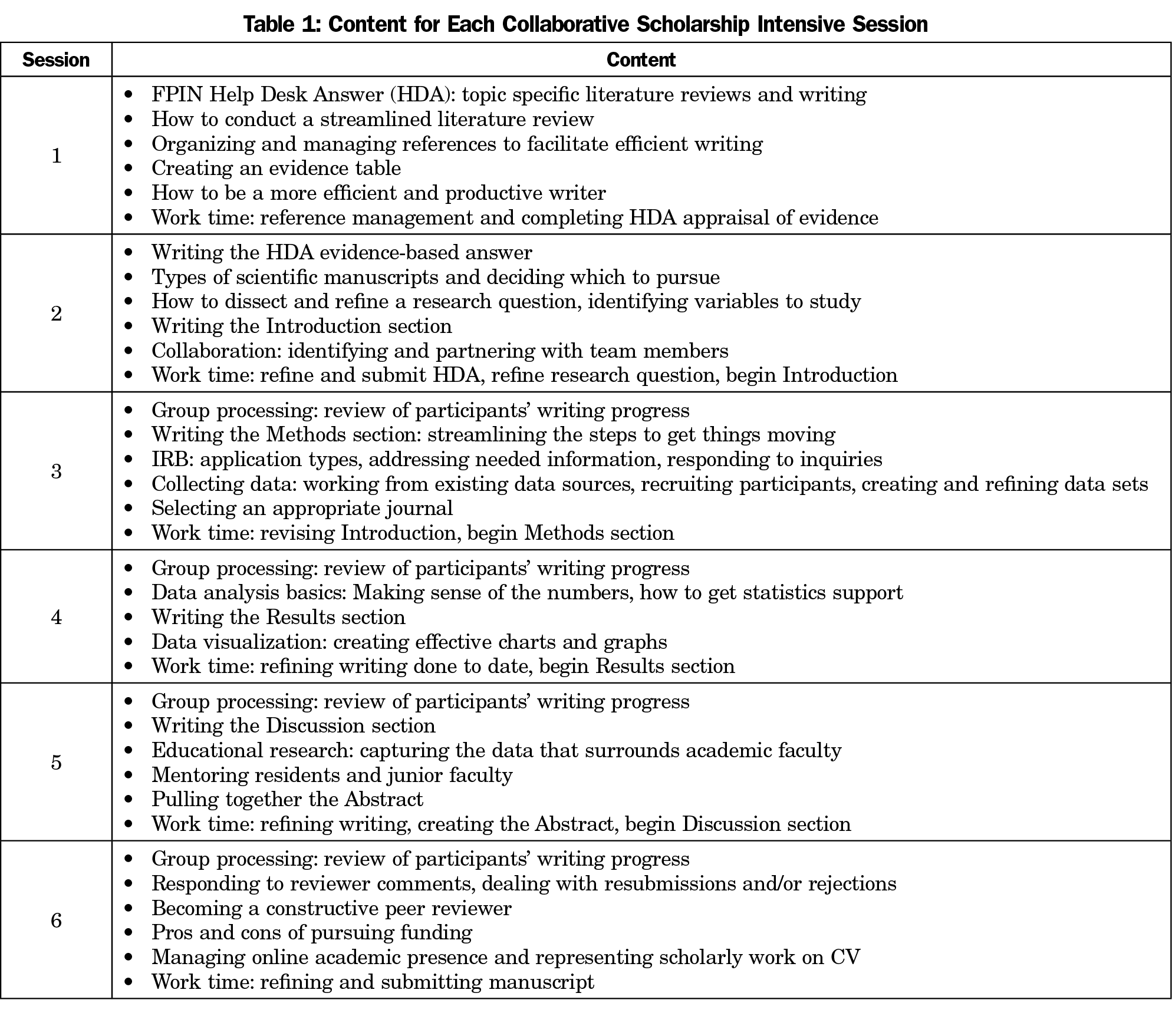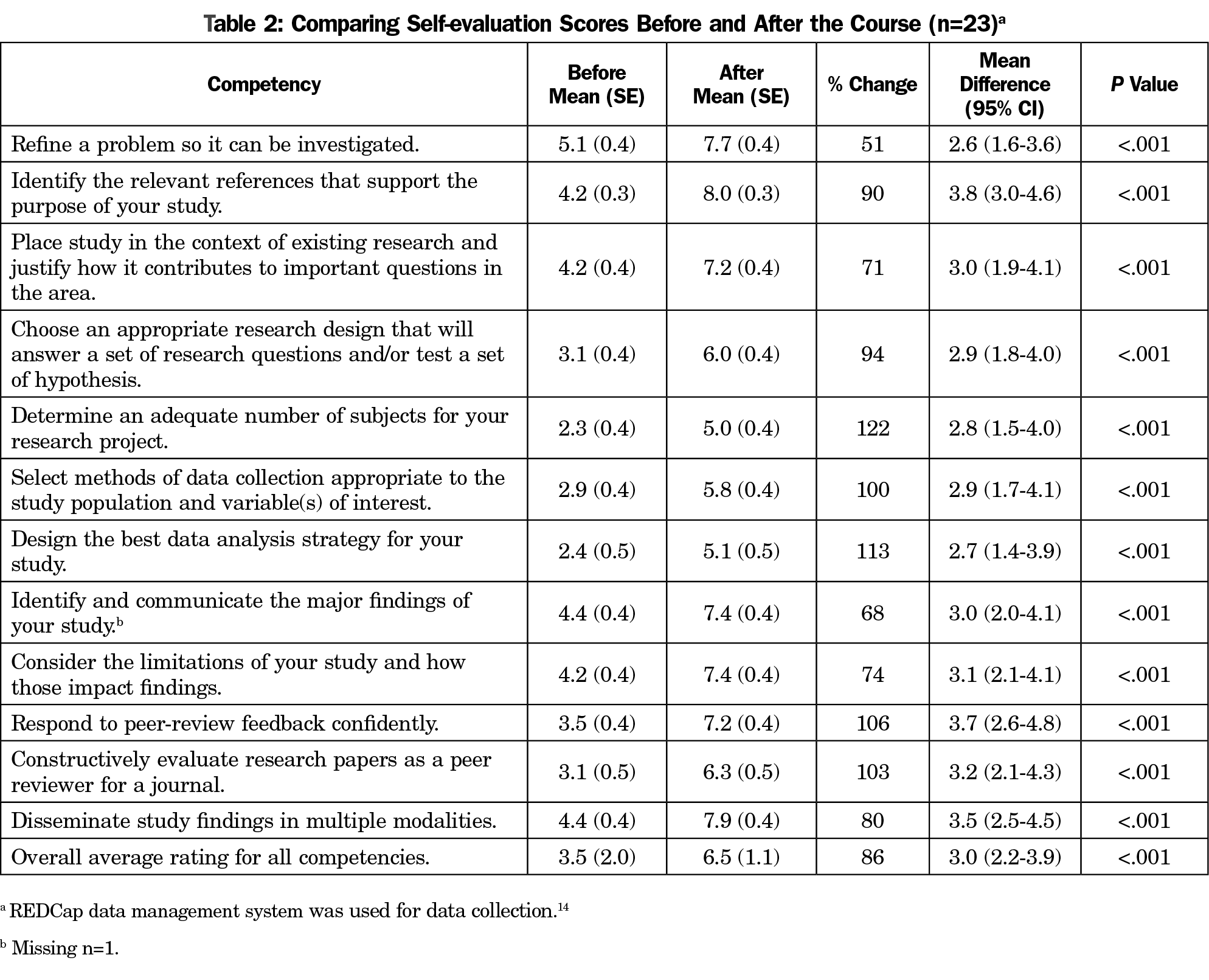Background and Objectives: Learning to balance the clinical, educational, and scholarly elements of an academic career is challenging for faculty. To increase research output amongst family medicine faculty with limited to no publications, we developed the Collaborative Scholarship Intensive (CSI) to provide participants with intensive instruction in research methodology coupled with structured writing support and protected time for writing.
Methods: The CSI was developed by the University of Minnesota Department of Family Medicine and Community Health as a six-session faculty development program that enrolled 23 participants in its first three classes.
Results: Findings reveal that faculty participants significantly improved their pre- to postcourse self-ratings of 12 research competencies, and significantly increased their scholarly output.
Conclusions: Our CSI faculty development program successfully engaged clinical faculty in a collaborative research program. Our results suggest that a program focused on intensive instruction in research methodology coupled with structured writing support and protected writing time may be a model for faculty development in other academic departments.
Balancing clinical, educational, and scholarly elements of an academic career can be challenging. Barriers to scholarship production are especially numerous (eg, time, competing priorities, inexperience),1,2 yet this is often a primary metric in faculty performance evaluation and promotion.3
Institutions have grappled with ways to support successful scholarship for clinical faculty. Workshops focusing on faculty publication productivity, peer support, and collaborative writing are common,2,4-12 although the structure of these varies greatly. Time frames range from 90 minutes to daylong events, held once or over the course of several months.8 Objectives vary from the writing process5,6,12 to training on specific writing skills.7 While beneficial, these models often don’t encompass all phases of research, such as data collection or analysis. Furthermore, as the majority of studies report pilot data or single cohorts, it’s unclear whether their impact is sustainable over more diverse groups or longer time frames.
Building on the strengths of previous models, we created the Collaborative Scholarship Intensive (CSI) with a goal of increasing scholarship output amongst faculty with minimal to no publication experience. We aimed to determine whether intensive instruction in research methodology, coupled with structured writing support and protected work time, increases faculty scholarship skills and output.
Setting/Recruitment
The University of Minnesota Medical School Institutional Review Board granted this study exemption from formal review for human subjects’ protection. We invited all 96 Department of Family Medicine and Community Health (DFMCH) faculty via email to register for CSI by completing an online form.
Participants included 19 physician (MD/DO) and four behavioral health (PhD/PsyD) faculty who participated in CSI over the first 3 years of the course. Nine faculty completed CSI in 2015, seven in 2016, and seven in 2017. All 23 participants were at the level of assistant professor with years on faculty ranging from 2 to 27.
Description and Procedures for CSI
Table 1 describes the six CSI sessions. In addition to 2.5 to 4.5 hours of focused instruction, each session included 1.5 to 3.5 hours of one-to-one work and writing time. Our faculty development team, career research faculty, and biomedical librarian provided the focused instruction and led the writing time. CSI participants were also supported by research staff experienced in practice-based research who provided assistance and instruction around specific aspects of research methodology.
One goal of CSI was for participants to add at least three scholarly products to their curriculum vitae including a 500 word peer-reviewed evidence summary, a presentation at a conference, and a manuscript submitted to a peer-reviewed journal.
Measures
Participant Feedback. At the conclusion of each session participants were asked to complete a brief evaluation of instructors and content. Although not used in course evaluation, this information was helpful in modifying course content and provided feedback on participant engagement.
Self-rated Competencies. Before and after the course participants used an 11-point Likert scale to rate their confidence in successfully performing 12 research competencies (Table 2).13 We calculated an average overall competency score for each participant as the mean of all 12 ratings (Chronbach α for pre=0.98, and post=0.93).
Scholarly Work. For each participant, we compared the quantity of scholarly work during the 1-year period preceding their start in the course to the quantity of scholarly work during the 1-year period following their start in the course. We defined scholarly work as the number of publications in any author position in a peer-reviewed journal, and oral/poster presentations at professional conferences.
Analysis Methods
We calculated means and standard errors for the 12 research competencies before and after the course. We used linear mixed models, each with a random intercept for participant ID, to test for differences in competencies before and after the course for all years combined. We used a paired t test to compare scholarly work from before to after the course.
All 12 competencies showed significant improvement pre- to postcourse (Table 2). The average overall competency score of pre- and postcourse ratings significantly increased from 3.8 (SE=0.3) to 6.7 (SE=0.3; 76% change, P<.001; Table 2).
Scholarly work significantly improved from before to after the course, with many participants exceeding productivity goals by partnering with classmates or other colleagues on multiple projects. Table 3 illustrates the increases in the number of publications (t22=6.86, P<.001), number of conference presentations (t22=3.38, P=.003), and total scholarly products (t22=6.41, P<.001) for all participants combined pre- and postcourse. The number of total scholarly products per participant was more than two times higher after the course (percent change=132%).
This program evaluation study examined the effectiveness of an innovative faculty development program. CSI participants had (1) significantly improved self-ratings of 12 research competencies, and (2) significantly increased scholarly output in pre- to postcourse comparisons.
An acclaimed feature of CSI was structured writing support and work time led by faculty with research and publishing experience. Participants consistently rated this as the most impactful aspect of the program with one commenting,
I really just loved having the work time with so many great resources and people to help us out. Even just talking about roadblocks with others in the course was incredibly helpful.
CSI may have contributed to a culture of collaborative scholarship that is netting additional benefit. Since CSI class 1 commenced, there has been more than an 80% increase in faculty publications across the department. Clearly we cannot attribute this increase to CSI alone. But as one participant commented,
I really loved the course and learned a ton. So glad to learn that this is not just about writing in a cubicle by yourself.
The direct costs for running CSI were largely contained to food for participants and instructors. The indirect costs were more substantial. Time for course planning and coordination by the administrator and director, instructors to present content, and participants to attend were the primary expense. Most participants used allotted continuing education hours to cover their time in the course.
Our results have limitations. The study sample size was small and limited to a single site and the three classes that completed CSI at least 1 year ago. Additionally, self-ratings on the 12 research competencies are prone to individual bias toward improvement, although this may be offset by the other primary measure of program success, that being an objective count of scholarship output. Next steps include broadening CSI to enroll faculty from other specialties at our university.
Our program successfully engaged clinical faculty with limited publication histories in collaborative research instruction. Initial analyses and participant feedback were positive, with an increase in both participant and departmental scholarship production.
Acknowledgments
Presentations: This study was presented at the North American Primary Care Research Group Conference, November 2016 in Colorado Springs, Colorado.
References
- Pittman J, Stahre M, Tomedi L, Wurster J. Barriers and Facilitators to Scientific Writing Among Applied Epidemiologists. J Public Health Manag Pract. 2017;23(3):291-294. doi:10.1097/PHH.0000000000000433
- Pololi L, Knight S, Dunn K. Facilitating scholarly writing in academic medicine. J Gen Intern Med. 2004;19(1):64-68. doi:10.1111/j.1525-1497.2004.21143.x
- Kairouz VF, Raad D, Fudyma J, Curtis AB, Schünemann HJ, Akl EA. Assessment of faculty productivity in academic departments of medicine in the United States: a national survey. BMC Med Educ. 2014;14(1):205. doi:10.1186/1472-6920-14-205
- Cable CT, Boyer D, Colbert CY, Boyer EW. The writing retreat: a high-yield clinical faculty development opportunity in academic writing. J Grad Med Educ. 2013;5(2):299-302. doi:10.4300/JGME-D-12-00159.1
- Steinert Y, McLeod PJ, Liben S, et al. Writing for publication in medical education: the benefits of a faculty development workshop and peer writing group. Med Teach. 2008;30(8):e280-e285. doi:10.1080/01421590802337120
- Brandon C, Jamadar D, Girish G, Dong Q, Morag Y, Mullan P. Peer support of a faculty “writers’ circle” increases confidence and productivity in generating scholarship. Acad Radiol. 2015;22(4):534-538. doi:10.1016/j.acra.2014.12.006
- Derish PA, Maa J, Ascher NL, Harris HW. Enhancing the mission of academic surgery by promoting scientific writing skills. J Surg Res. 2007;140(2):177-183. doi:10.1016/j.jss.2007.02.018
- McGrail MR, Rickard CM, Jones R. Publish or perish: a systematic review of interventions to increase academic publication rates. High Educ Res Dev. 2006;25(1):19-35. doi:10.1080/07294360500453053
- Reader S, Fornari A, Simon S, Townsend J. Promoting Faculty Scholarship - An evaluation of a program for busy clinician-educators. Can Med Educ J. 2015;6(1):e43-e60. doi:10.36834/cmej.36666
- Chan TM, Gottlieb M, Sherbino J, et al. The ALiEM Faculty Incubator: A Novel Online Approach to Faculty Development in Education Scholarship. Acad Med. 2018;93(10):1497-1502. doi:10.1097/ACM.0000000000002309
- Franks AM. Design and Evaluation of a Longitudinal Faculty Development Program to Advance Scholarly Writing Among Pharmacy Practice Faculty. Am J Pharm Educ. 2018;82(6):6556. doi:10.5688/ajpe6556
- Rickard CM, McGrail MR, Jones R, et al. Supporting academic publication: evaluation of a writing course combined with writers’ support group. Nurse Educ Today. 2009;29(5):516-521. doi:10.1016/j.nedt.2008.11.005
- Sorkness CA, Pfund C, Ofili EO, et al; Duplicate Of Weber-Main; NRMN team. A new approach to mentoring for research careers: the National Research Mentoring Network. BMC Proc. 2017;11(S12)(suppl 12):22. doi:10.1186/s12919-017-0083-8
- Harris PA, Taylor R, Thielke R, Payne J, Gonzalez N, Conde JG. Research electronic data capture (REDCap)—a metadata-driven methodology and workflow process for providing translational research informatics support. J Biomed Inform. 2009;42(2):377-381. doi:10.1016/j.jbi.2008.08.010






There are no comments for this article.